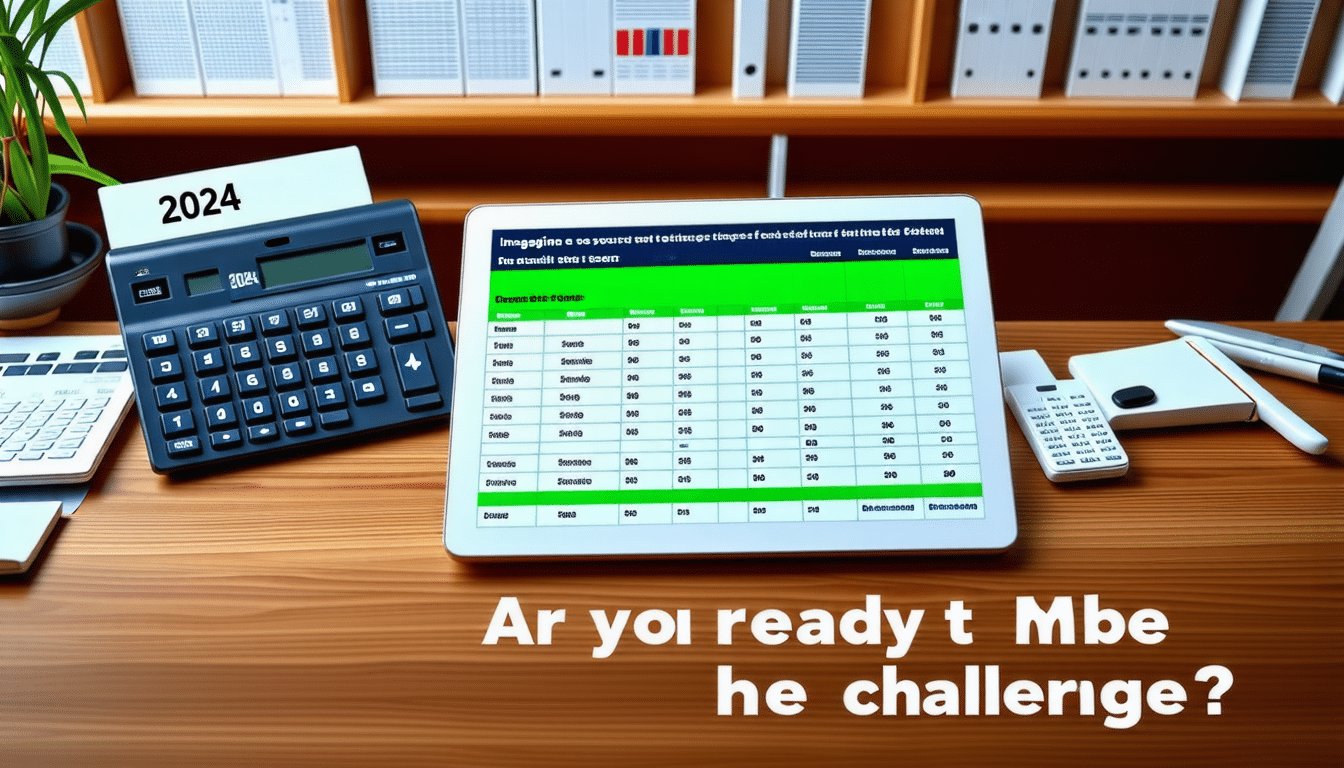Conquering the 2024 Balance Sheet Deadlines: A Comprehensive Guide for Your Company

In this article, find out how to anticipate and effectively manage your company’s balance sheet deadlines in 2024. We’ll provide you with strategies and practical tools to help you prepare for this crucial deadline. Ensure the compliance and performance of your financial management to meet the challenge successfully.
Understanding the Regulatory Requirements for 2024

Filing deadline
For 2024, companies need to be particularly vigilant when it comes to the closing and filing dates for their balance sheets. In France, the usual closing date for most companies is December 31. However, the deadline for filing the balance sheet is generally four months after the end of the financial year, i.e. before April 30 of the following year. Respecting this deadline is crucial to avoid penalties.
Changes in accounting standards
From 2024 onwards, a number of important changes to international accounting standards (IFRS) and local accounting standards (French standards) will come into force. These changes may affect the way in which assets and liabilities are valued, as well as the classification of certain balance sheet items. It is essential that accounting professionals keep abreast of these developments to ensure that their practices are compliant.
Increased transparency requirements
Faced with growing demands for financial transparency, companies will have to provide more detailed information in their balance sheets. This includes more in-depth explanations of revenue sources, inventory valuation methods and off-balance sheet commitments. The clarity and precision of this information is essential to meet the expectations of auditors and stakeholders alike.
Reporting technologies and tools
The use of modern accounting and reporting technologies is becoming a necessity for effective management of the balance sheet process. Advanced accounting software, incorporating artificial intelligence and automation, can significantly reduce the risk of errors and optimize data processing time. Investing in these technologies can pay dividends in improving the accuracy and efficiency of the balance sheet.
Preparation and training
Companies are advised to actively prepare their staff for the changes ahead through targeted training courses, particularly on new accounting standards and modern technological tools. Good preparation minimizes the stress associated with approaching regulatory deadlines, and boosts the confidence of the teams in charge of preparing the financial statements.
Assistance tools and resources available
A wide range of tools and resources are available to help professionals meet their obligations. These include practical guides, webinars, training seminars and specific software. Using these resources can help companies navigate the complex regulatory landscape of 2024 effectively.
Efficient preparation of the Annual Review

Preparing an annual balance sheet is a crucial step for any business, as it reflects the company’s financial state at the end of the financial year. It’s a task that requires precision and organization to ensure compliance with accounting standards and meet the expectations of various stakeholders, including investors, banks and tax authorities.
Understanding balance sheet items
A balance sheet consists of two main parts: assets and liabilities. Assets include everything the company owns, while liabilities include its debts and obligations. Preparation of the balance sheet begins with a careful review of these elements to ensure their accuracy.
Collecting and reviewing accounting data
To prepare an accurate balance sheet, it is essential to collect all accounting data during the year. This includes all documents relating to transactions, such as invoices, bank statements and contracts. Reviewing these documents ensures that all transactions are correctly recorded and classified.
The role of accounting software
The use of appropriate accounting software can greatly simplify balance sheet preparation. These tools centralize and automate the management of financial data, providing an accurate, easy-to-analyze overview. What’s more, they help minimize human error during calculations.
Tax implications and meeting deadlines
The annual balance sheet has important tax implications. It forms the basis for calculating corporation tax, and must be submitted on time to avoid penalties. Keeping a calendar of all tax deadlines is therefore crucial to efficient management.
Internal audit and validation
Before final submission, an internal audit may be useful to validate the balance sheet. This involves systematically checking the figures, processes and procedures used to compile the balance sheet. This enables any anomalies to be identified and corrected before the balance sheet is considered final.
Preparing for external audits
Once the balance sheet has been drawn up, it is often subject to review by external auditors or tax advisors. Having all the supporting documentation, being ready to explain accounting choices and having clear communication with these external parties are fundamental aspects in facilitating these reviews and ensuring their smooth running.
Time management and meeting deadlines
Understanding the challenges of an effective balance sheet
The financial balance sheet is a snapshot at a given point in time of what a company owns and owes. It is crucial not only for assessing the company’s financial health, but also for meeting legal obligations and attracting potential investors. The key to an optimized balance sheet lies in rigorous preparation and meticulous organization throughout the fiscal year.
Advance planning: the basis of efficiency
Effective time management is essential to ensure that all the information required to prepare the balance sheet is collected and processed on time. Scheduling reminders for key dates, such as the closing of monthly or annual accounts, ensures that nothing is left to chance. The use of calendar tools or project management software can be very helpful in staying on track.
Automating accounting processes
Adopting modern accounting software can drastically reduce errors and time spent on the manual aspects of bookkeeping. These tools are capable of synchronizing data in real time, automating transaction entry and producing periodic financial statements. They are a major help in ensuring the accuracy and consistency of financial data throughout the year.
Techniques for fast, efficient account closing
- Clear classification of entries: Every transaction should be recorded in the right category from the outset, to avoid confusion and last-minute corrections.
- Regular review of pending accounts: Instead of waiting until the end of the year, carry out monthly or quarterly reviews to ensure that everything is in order.
- Focus on anomalies: Any significant discrepancies should be investigated immediately. This prevents surprises when the final balance sheet is consolidated.
Updating tax and accounting knowledge
Accounting standards and tax laws are constantly evolving. Keeping abreast of the latest changes is crucial to ensuring balance sheet compliance. Taking part in training courses, webinars and subscribing to specialized newsletters are effective ways of staying up to date and ensuring the accuracy of financial statements.
Internal collaboration and communication
Balance sheet preparation is not the exclusive preserve of the accounting department. It involves coordination with other departments such as sales, procurement and human resources. Establishing smooth and regular communication between these departments ensures that all relevant financial information is correctly reported and taken into account.
Preparing for audits
A well-prepared balance sheet greatly facilitates the audit process. Organizing and systematically storing all necessary supporting documents is essential. This not only helps to answer auditors’ questions easily, but also reduces the time needed for the audit, minimizing disruption to the company’s day-to-day business.
Implement strict internal controls
Implementing robust internal controls is an effective way of preventing errors and fraud. These controls contribute to the reliability of financial information and enable a smooth preparation of the balance sheet. They include data cross-checking mechanisms, transaction authorizations and regular internal audits.
Avoiding Common Pitfalls in Financial Closing
Understanding common errors
Closing accounts can often lead to errors if proper vigilance is not applied. One of the most common errors includes the incorrect categorization of expenses and income, thus disrupting the accuracy of the balance sheet. It is crucial that each financial item is correctly allocated to reflect the company’s economic reality.
Anticipating last-minute adjustments
Year-end corrections can turn a normally smooth accounting routine into a real headache. It is advisable to review accounts regularly during the year to avoid a pile-up of corrections that could mask deeper problems, such as systematic errors in data entry or in the recognition of income and expenses.
Ensuring regulatory compliance
Accounting standards are evolving, and keeping up to date with these changes is essential to avoid penalties at the closing of accounts. Investing in ongoing training for accounting staff and regular consultation with chartered accountants or auditors can prove beneficial in maintaining compliance with current regulations.
Use of accounting software
Technological tools such as accounting software are indispensable for efficient closing of accounts. Not only do they enable accurate recording of transactions as they occur, they also enable efficient compilation and review of financial data, reducing the risk of manual errors.
Internal communication and collaboration
Communication between departments is essential. Closing errors often stem from a lack of collaboration between teams, for example, the failure to communicate essential financial data on time between the sales and accounting departments. Transparent, real-time communication promotes a smooth closing of accounts.
External auditing
It is often beneficial to call in external auditors for an objective review of the accounts before the final closing. This helps to identify and rectify errors that may have been overlooked by the in-house team, offering additional assurance as to the accuracy of the final financial statement.
Optimizing resources for the balance sheet
Effective resource management is crucial to the preparation of a sound and reliable balance sheet. This aspect of accounting requires the implementation of various strategies to ensure that all resources are properly valued, documented and optimized.
Strategies for reviewing assets and liabilities
To optimize available resources and ensure their accuracy in the balance sheet, certain methods can be applied systematically. Firstly, a detailed review of all assets and liabilities is recommended. This includes checking depreciation, valuing inventories and reconsidering receivables and payables. Asset management tools can automate this process, reducing errors and increasing efficiency.
Use of accounting software
The adoption of modern accounting software makes it much easier to optimize resources for the financial balance sheet. These tools offer advanced features such as automatic transaction integration, real-time classification of financial data and advanced analysis modules. Choosing the right software can transform the way data is processed and significantly improve balance sheet results.
Training and updating skills
Ongoing training of accounting staff is essential. New accounting standards, tax legislation and auditing methods evolve regularly. Organizing regular training sessions ensures that the team is up to date with the latest practices and technologies, which in turn optimizes resources for the balance sheet.
Regular planning and monitoring
Finally, strategic planning and regular monitoring are fundamental. It’s a good idea to set up a reporting and follow-up calendar not only to prepare the annual balance sheet, but also to monitor and adjust financial strategies throughout the year. This ensures greater responsiveness to economic fluctuations and opportunities that may arise.
Ensure Compliance and Avoid Penalties
Understanding the Regulatory Requirements of the Balance Sheet
An accurate financial balance sheet is crucial not only to a company’s health, but also to compliance with legal requirements. Legislation requires companies to present their accounts transparently and at regular intervals. It is essential that all financial transactions are properly documented and classified in appropriate accounts to avoid errors that could lead to regulatory breaches.
National and international accounting standards, such as IFRS or GAAP, provide guidelines on how to account for different business transactions. Ensuring that the balance sheet complies with these standards not only helps to maintain financial clarity, but also enhances the company’s credibility with investors, lenders and other stakeholders.
Upstream planning and preparation
Preparing an accurate balance sheet requires meticulous planning and organization throughout the year. This involves regular bookkeeping and periodic review of accounts to ensure accuracy. The use of reliable accounting software can greatly assist in tracking transactions systematically and generating interim reports as a basis for the annual balance sheet.
It is also advisable to carry out monthly bank reconciliations to ensure that accounting records match bank statements. By anticipating potential errors and correcting them as they occur, the year-end workload is considerably reduced.
Setting up internal controls
Establishing effective internal controls is another key strategy for ensuring balance sheet integrity. These controls can include segregation of duties to reduce the risk of fraud, as well as regular reviews of accounting processes by a manager or internal auditor. This not only identifies inconsistencies that could affect the accuracy of the balance sheet, but also reduces the risk of financial malfeasance.
Regular internal audits can also play a crucial role in providing objective assurance as to how financial resources are being managed. These audits help identify areas for improvement, and help prepare the company for mandatory external audits.
Strategies for avoiding penalties
One of the most serious consequences of an inaccurate balance sheet is the possibility of incurring regulatory penalties. To avoid these, it is crucial to meet all tax and regulatory deadlines. This includes submitting annual accounts to the relevant authorities and paying all taxes due.
Also, open communication with tax and financial advisors can help identify potential areas of tax risk and develop strategies to tackle them effectively. By remaining proactive and well-informed of legislative changes, companies can adjust their accounting practices in good time to remain compliant.
In short, the key to avoiding penalties lies in careful preparation, scrupulous adherence to accepted accounting practices and constant vigilance regarding regulatory developments. By adopting a proactive and organized approach, companies can ensure that their balance sheet is not only compliant, but also a true reflection of their financial health.